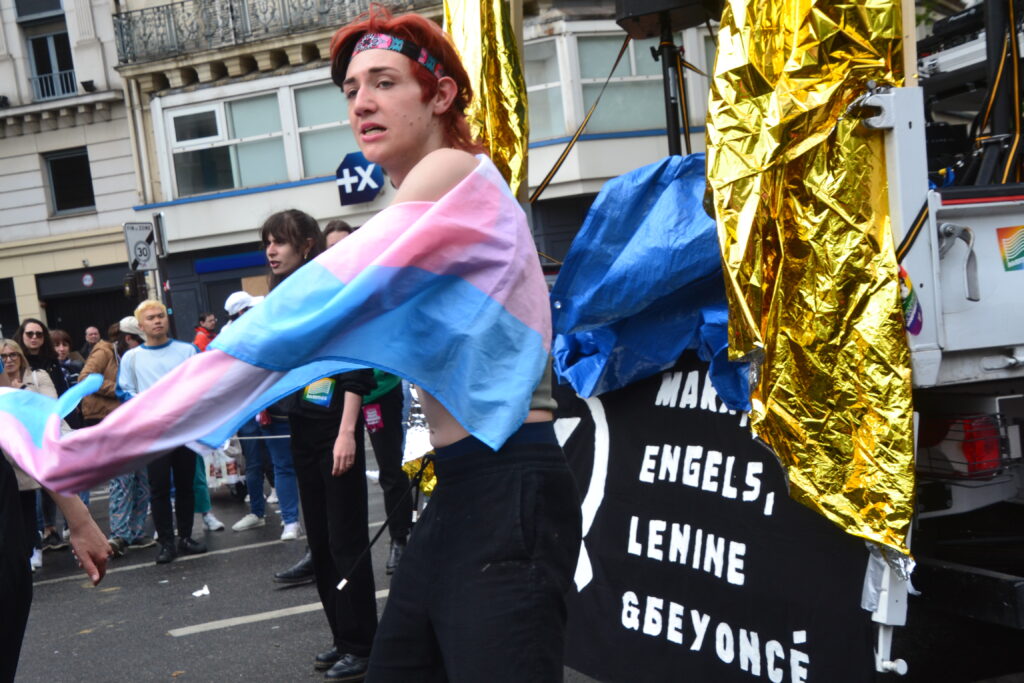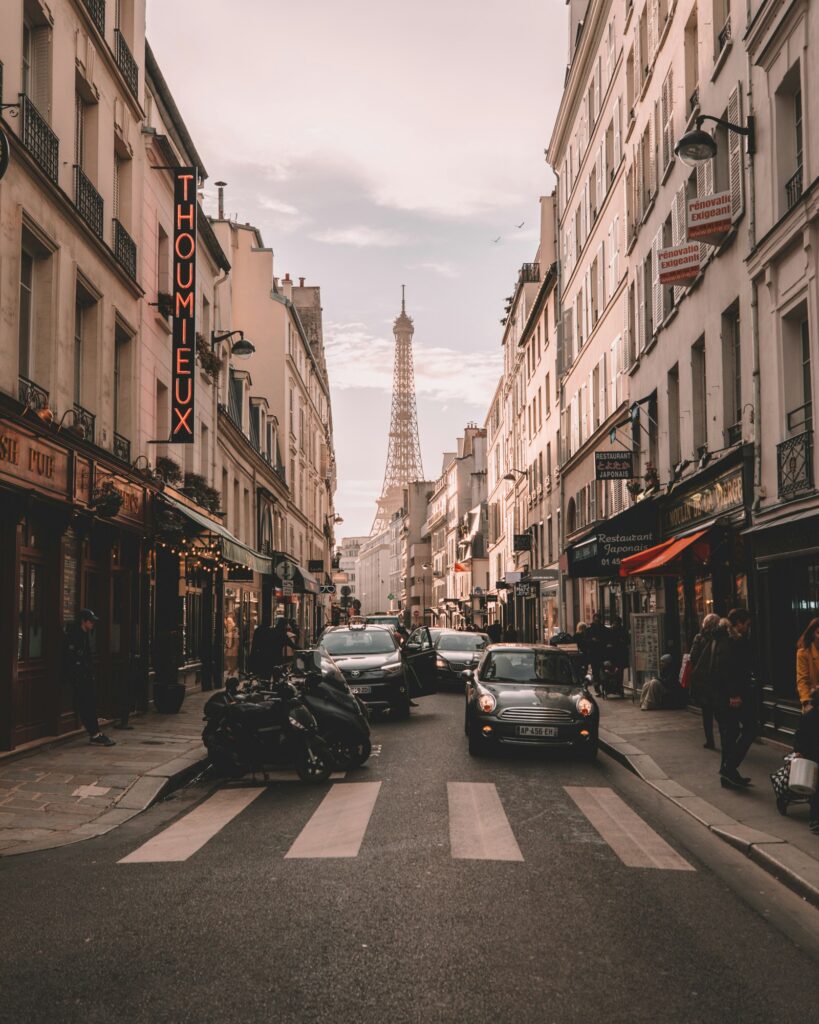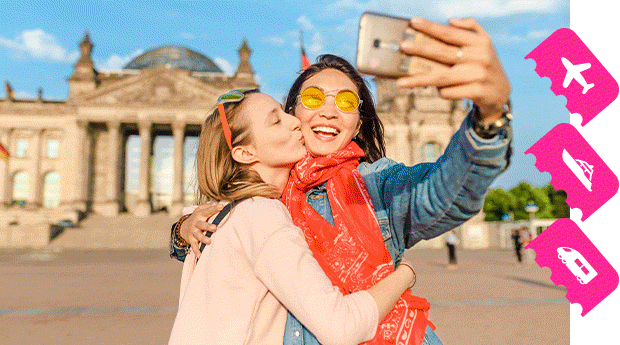To folks outside of France, the French are all a tad gay. That’s not their fault. It’s the result of centuries of efforts to position France as a nexus of culture, etiquette, luxury and refinement—concepts not usually associated with beer-guzzling hockey bros. However, the stereotype is also a bit off. While such qualities are certainly championed in France, they don’t necessarily dictate the daily lives of French people. French cities, especially Paris, are studies in contrast, blending incongruent grittiness with impressionistic scenes of lovers in the grass. Though writers, artists and filmmakers around the world have perpetuated the idea that Paris is a cauldron of romance and inspiration, the idea is actually a myth—an invention of starry-eyed tourists repeated ad nauseam.
Still, there’s a reason that Paris has charmed and mystified so many tourists. Harbouring more than 13 million people in the 20 districts—or arrondissements—within its metro, it’s a massive conglomeration of world-renowned landmarks, museums, restaurants, bars, clubs and boutiques. Despite the terrible drivers, you’ll find plenty in Paris to write home about. Naturally, there are the greatest hits, such as the Eiffel Tower, the Louvre, Notre-Dame Cathedral and the sinuous Seine, but Paris has more to offer than tourist traps. It’s the art, fashion and culinary capital of the world, after all. Did you know that Monet’s famous Water Lilies series is not in the Louvre or the Musée d’Orsay, but rather the Musée de L’Orangerie, tucked away in the Tuileries? The revelations don’t stop there.
In the bohemian Montmartre district of the 18th arrondissement lies the real-life Moulin Rouge (82 Bd de Clichy, Paris), where cabaret shows still delight modern-day visitors. Meanwhile, over in the 10th, the trendy and tranquil Canal Saint-Martin area comprises both culinary gems and offbeat boutiques. The Latin Quarter, on the other hand, conceals the Panthéon (Pl. du Panthéon, 75005 Paris), the final resting place of Marie Curie, amid its youthful and raucous crowds. And while the 8th proudly possesses the iconic Arc de Triomphe and Champs-Élysées, as well as the latter’s flagship Louis Vuitton store, it’s the 3rd that best evokes the popular image of Paris. Its crooked and cobbled streets wind past chic models, speakeasies, antique markets and terraces, lulling even the most cynical traveller into a state of wonder.

Still, it’s the Marais district that demands the attention of LGBTQ+ travellers. Straddling the 3rd and 4th arrondissements, this historically ghettoized quartier of the city has been the epicentre of Parisian queer life for decades—it’s the party capital of France. Every June, queer carousers from around the world vogue across the “queer quartier” during Paris’s LGBT Pride celebrations. That’s not to mention the phenomenal queer bars and boutiques that make Marais a must-stay spot for any queer traveller. You won’t have to worry about holding hands or openly kissing your partner in Marais (or pretty much anywhere else in central Paris): In addition to being famously polyamorous, French people are quite accepting of their queer brethren. Equal marriage has been legal in France since 2013, employment discrimination and so-called conversion therapy are illegal—non-binary gender recognition is the only item on the modern queer policy checklist France is missing. On the gossipy side of things, President Emmanuel Macron has been rumoured to “go fishing” with male political advisors, to use Brokeback Mountain terminology, though he has laughed that off. Historically, homosexuality and bisexuality have been less contentious in the culture compared to, say, Britain, where public attitudes have made sharper turns toward the negative.
France’s laissez-faire approach to sexual diversity shouldn’t be surprising. The country was the birthplace of one of Europe’s most famous revolutions, between 1789 and 1799, when commonfolk far and wide rebelled to unseat their no-good royals. Laws against homosexuality were repealed during the French Revolution in 1791; Britain repealed its homosexuality laws 176 years later. This is a country built upon “liberty, equality, and fraternity.” Thus, Paris isn’t just the City of Light because its Eiffel Tower sparkles every night; it’s the City of Light because its people believe themselves to be enlightened. Parisians range from foul-mouthed ruffians to unflappable waiters, from corny mimes to disaffected pot-smoking teens. But all of them—student, doctor, entrepreneur, artist—are in love with their city. Sous le ciel de Paris, everyone feels equal among the splendour.

So grab a baguette (or croissant or macaron), open up the Citymapper app and figure out which metros will get you to the must-see spots with this Insider Guide to Paris. If Paris is the best of French culture in a nutshell, then it’s time for you to experience all of the city’s culture, etiquette, luxury and refinement for yourself. Here’s our guide to the best of LGBTQ+ Paris.
What to see and do
The Louvre. This immense former palace, perhaps the most famous museum in the world, contains as many queer curios as it does famous pieces such as the Mona Lisa and Venus de Milo. Don’t miss the Sleeping Hermaphrodite statue or Michelangelo’s Dying Slave, dubbed his “most blatantly homoerotic work.” Various private tour operators offer queer-themed tours around the museum. Afterwards, take a stroll through the enchanting Tuileries Gardens that are just past the Louvre Pyramid.
Tour Montparnasse (33 Av. du Maine, Paris). You don’t need us to recommend the Eiffel Tower to you. But if you want a less stressful climb and an arguably better view of Paris, then consider Montparnasse Tower. It’s located in the 15th arrondissement, at Paris’s outskirts.
Père Lachaise Cemetery. A pensive walk through this cemetery will take you past queer icons such as Colette, Proust, Gertrude Stein (and her partner, Alice B. Toklas), as well as Oscar Wilde and his paramour Robbie Ross.
Sacré-Cœur Basilica (35 Rue du Chevalier de la Barre, Paris). The interior mosaics of this domed white church are as magnificent as the views glimpsed from its front yard. Pair it with a visit to the nearby Moulin Rouge, which frequently hosts queer programming in its “La Machine du Moulin Rouge” event space.
Musée D’Orsay (Esplanade Valéry Giscard d’Estaing, Paris). Though not as famous as the Louvre, this former train station has just as many famous works. Its collection of impressionist paintings by Monet, Manet, Renoir, Van Gogh, et al. will instantly take you back to Art History 101. Though it doesn’t have as much queer work as the Louvre, it does have a portrait by Giovanni Boldini of Robert de Montesquiou, the dandy aristocrat who was the model for the horny pansexual Charlus character in Proust’s In Search of Lost Time.
Les Catacombes (1 Av. du Colonel Henri Rol-Tanguy, Paris). A famously macabre stop for tourists in Paris is the Catacombs, an underground tunnel network that contains the skeletons of over six million Parisians. The inscriptions of existential Latin and French poetry along the way will heighten your feeling of sublime unease.
Centre Pompidou (Place Georges-Pompidou, Paris). This contemporary art museum in Marais looks to be perennially under construction thanks to its exoskeleton of escalators and exposed pipes. People have been debating about it since it opened in 1977. For that alone, it’s worth a visit, but it also boasts tons of queer art.
Palace of Versailles (Place d’Armes, Versailles). Though outside Paris, Versailles is an essential stop for anyone visiting the City of Light. This over-the-top former home of French royals is now an expansive constellation of fountains, gardens and exquisite décor. Though it was built by Louis XIII, it was during Louis XIV’s reign (1643–1715) that Versailles got super gay. Mr. XIV had sex with men and there were many homosexual affairs in his court. Book a guided tour to get the full experience.
Where to stay
Hôtel Jules & Jim (11 Rue des Gravilliers, Paris). This queer-owned hotel in the heart of Marais is housed in a former processing plant. Yet the tastefully decorated space has a bar, a fully equipped gym and an art gallery on site. Oh yeah, and lots of queer staff and guests.
Maison Proust (26 Rue de Picardie, Paris). Paris has a grand literary tradition and has welcomed every writer from Voltaire to Ernest Hemingway. France’s own Marcel Proust, who never came out but filled his masterpiece novel with queer characters and themes, has his own hotel dedicated to him, complete with suites themed after his characters and the Parisian cultural universe that inspired them. They’ve also got a luxurious spa. A bit of history: In 1891, Proust once invited fellow closeted gay, Irishman Oscar Wilde, to dinner at his Parisian home. Wilde is said to have locked himself in the bathroom, then fled.
L’Hôtel (13 Rue des Beaux Arts, Paris). Despite being the place where Oscar Wilde died, L’Hôtel is queer friendly these days—you’ll do just fine here. No longer the relatively modest inn of Wilde’s time, L’Hôtel is now a sumptuous French Empire–style spectacle with a cocktail bar and a live music venue lovingly called Wilde’s.
Five Boutique Hôtel Quartier Latin (3 Rue Flatters, Paris). Found in the spirited Latin Quarter, this subdued and hip hotel is happy to host queer travellers in its colourful rooms.
Mama Shelter (109 Rue de Bagnolet, Paris). This youthfully inclined hotel welcomes queer budget-conscious travellers with its funky decor and proximity to Oscar Wilde’s final resting place at the Père Lachaise Cemetery. Check out the rooftop terrace.
Generator Paris Hostel (9-11 Pl. du Colonel Fabien, Paris). The Paris branch of this chain of hip, contemporary hostels has private and dorm rooms. They throw great parties on their rooftop deck and at their in-house nightclub.
Where to eat
Ladurée (75 Av. des Champs-Élysées, Paris). You can’t visit Paris without sampling its famous pastries, and there are few better places to do that than Ladurée, an icon of the city.
Boulangerie M’seddi (215 Bd. Raspail, Paris). Owner Mahmoud M’seddi has won “Best Baguette of Paris” in the past, so you know this place is good. Order the “baguette tradi” and prepare to enter bread nirvana.
Café de Flore (172 Bd. Saint-Germain, Paris). Paris is known for its cafés, so you might as well stop by the most famous of them. Its cream-coloured umbrellas and cursive sign are instantly recognizable to those in the know: In the past, this was “the spot” for Paris’s intellectual class.
Des Gars dans la Cuisine (72 Rue Vieille du Temple, Paris). This elegant queer-owned bistro serves internationally inspired French fare in a friendly environment. The impressive wine list and seasonal plats du jour keep things fresh.
Le Refuge du Passé (32 Rue du Fer à Moulin, Paris). For pitch-perfect cassoulet, scrumptious sweetbread and terrific tarte tatin, pop into this quirky culinary enclave in the city’s 5th arrondissement.
Les Marronniers (18 Rue des Archives, Paris). No visit to Paris is complete without a relaxed two-hour stretch of people-watching at any one of the city’s best cafés. Why not spend the time at this bustling rainbow flag–clad patio in the centre of Marais?
Table (3 R. de Prague, Paris). Its simple name belies the complexity of its dishes. This expertly laid-out restaurant in the 12th arrondissement has been named one of the Top 50 Restaurants in the World on multiple occasions. Try the lobster with sugar snap peas or the nettle and caper remoulade.
Where to party
Paris is a big LGBTQ+-friendly city, but exploring the gay scene of the moment can be tricky. Many of the bars are located in Le Marais, roughly between Le Louvre and Place de la Bastille, which is the gayest part of the city but not quite a classic gay village—it’s a big area and quite mixed. As rents here have gone up, queer venues have been pushed out of Le Marais, with some settling nearby. And like many global capitals, there are weekly, monthly and annual club nights that bounce around from venue to venue.
Here are some classic stops that will give visitors an entry point into the scene.
freedj (35 Rue Sainte-Croix de la Bretonnerie, Paris). This neon-powered queer-owned club on two levels is beloved for its boisterously and flirty basement dance floor. Guys should be prepared to do some flirting and get wild.
Le Raidd (23 Rue du Temple, Paris). This relatively cozy spot makes up for its small size by hosting shower shows, which feature handsome men taking showers in transparent cases on stage. The shirtless bartenders don’t hurt either. If you’re immune to eye candy, have a drink at one of its sidewalk tables.
Banana Café (13 Rue de la Ferronnerie, Paris). This streetside hangout is known for its sherbert-coloured interior, its Drag Race France watch parties and its happy hours that last until 11 p.m.
La Mutinerie (176-178 Rue Saint-Martin, Paris). If you prefer a bit of intellectual discourse with your flirtations, then visit this women-owned trans-friendly feminist space, where drag shows tend toward the political and the parties usually benefit charity.
La Champmeslé (4 Rue Chabanais, Paris). One of the busiest lesbian establishments in Gay Paris, and with a history dating back to the early 1970s, La Champmeslé attracts a diverse blend of partiers with its themed nights, friendly vibes and international flavour. An essential sapphic stop both for the history and the party.
Le Klub (14 Rue St. Denis, Paris). Can you guess what the name means? Zero points if you got it right. Anyway, this multi-level industrial space hosts concerts, ragers and performance art within its graffitied, stony walls. Much of what it does is queer, alt and edgy—but also techno.
Who’s Bar (14 Rue Saint-Merri, Paris). Who’s what, you ask? Maybe you’ll find out the answer if you stay until closing time at 6 a.m. at this sleek and metallic club, which specializes in drag shows and dancing, though they’re also known to throw Eurovision parties.
Where gay and bi guys can find fun
Xkboys (150 Rue Saint-Maur, Paris). This sex club/cruising bar, formerly known as the Bunker, has lockers, cabins and all you’d expect from a club that hosts regular fetish nights (leather, rubber, sport).
Full Metal (40 Rue des Blancs Manteaux, Paris). This cruising club encourages patrons to wear whatever turns them on, but also to follow the dress code on designated club nights (hint: usually leather). Nasty in the best sense.
L’Impact (18 Rue Greneta, Paris). Don’t like to make decision about which gear to wear to the cruisebar/sex club? This is the only all-naked gay bar in the city, though there are nights where patrons can wear a mask or hood.
Sun City Sauna (62 Bd. de Sébastopol, Paris). The French capital’s biggest gay sauna is so well-known that tourists here often outnumber the locals. In addition to the usual cabins, mazes and dark spaces, they’ve also got a pool and a surprisingly well-equipped gym. The music’s not bad either.
IDM Sauna (4 Rue du Faubourg Montmartre, Paris). This four-floor sauna in the Opera Quarter is second only to Sun City in size and popularity. Thursdays and Fridays are naked nights, and it’s free entry on your birthday.
Atlantide Sauna (13 Rue Parrot, Paris). Paris has one of those rare sex-positive saunas that’s not exclusively for men. Founded in 1999, it welcomes all the letters in the LGBTQ+ acronym, and even open-minded straight people (as long as they practise good hygiene—that comes up a lot in the FAQ). Customers who present at reception as a woman get a discount on their entry fee.
Where to shop
Les Mots à la Bouche (37 Rue Saint-Ambroise, Paris). Paris’s oldest gay bookstore has a lineup of excellent books and magazines in both French and English. To browse their large selection of art and photography books, you don’t need to speak either language. They also have knick-knacks and souvenirs galore. It’s easy to get lost exploring.
Violette and Co (52 Rue Jean-Pierre Timbaud, Paris). This woman-owned feminist bookstore, founded in 2004, is the go-to spot for Paris’s smartest queer women. Its café hosts a never-ending schedule of literary salons.
BHV Marais L’Homme (36 Rue de la Verrerie, Paris). This branch of the French department store is dedicated to male style and boasts four floors of luxury and semi-luxury streetwear, brand name statement pieces, accessories and perfumes. If style has a sexual orientation, the style here is discerningly gay.
Les Dessous D’Apollon (8 Rue de Moussy, Paris). This mega-gay megastore lines its shelves with men’s underwear of every shape and colour. You can find loungewear and swimwear as well.
IEM (16 Rue Sainte-Croix de la Bretonnerie, Paris). Founded in 1980, this is Paris’s foremost gay fetish boutique. Latex, leather and toys, oh my! Also: magazines, gels, stimulants and accessories.
TOF Paris (55 Rue Montmartre, Paris). This menswear shop’s slogan is “born to party,” and you can’t underdress for the party they’re thinking of. Jocks, G-strings, harnesses, tank tops—anything is outerwear these days.


